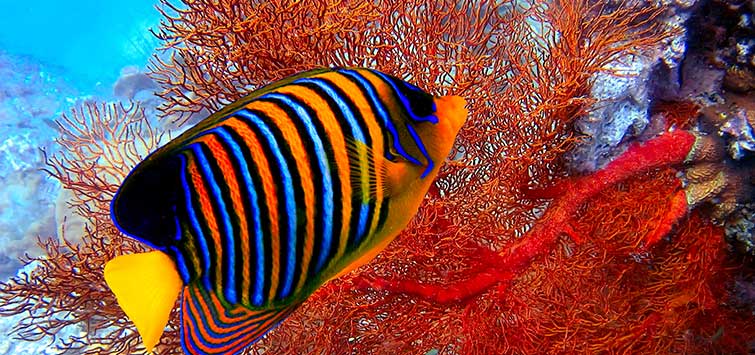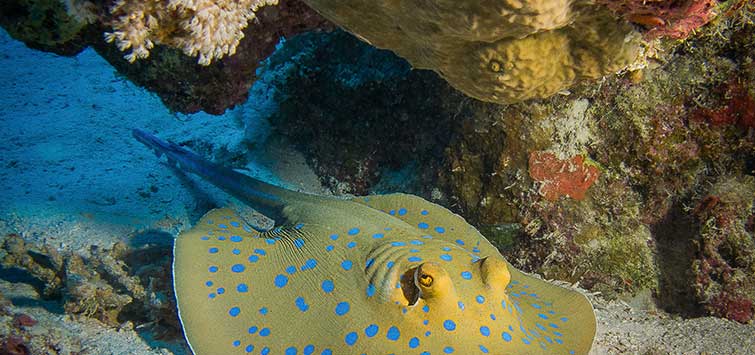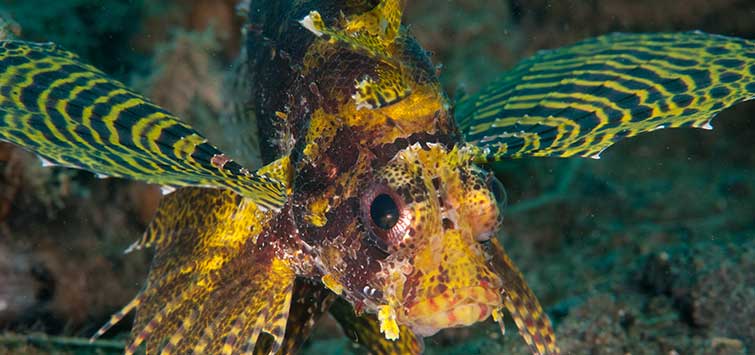Beauties of the Red Sea
Author: John Robertson
A diver who finds inspiration on the world’s coral reefs describes the beautiful fish and underwater scenery that captivated him as he explored Egypt’s Red Sea coast.
The diversity of marine life at Sharm el Sheik on Egypt’s Red Sea coast always seems to provide something new to discover, and I spotted over 150 species on my last trip there. Some of the area’s fishes rank among the world’s most beautiful, such as the regal angelfish that weaves its way about the labyrinthine tunnels of the coral reef. Some are beautiful more in their swift, graceful movements, like the various surgeonfishes that glide in sweeping arcs as they display to each other over the reef crest.
The Regal Angelfish
The regal angelfish (Pygoplites diacanthus) is common along the top of the reef and among dense corals. It feeds mainly on sponges and coral polyps and grows to about 10 inches (25 cm). Individuals appear to know their territory very well, and when you approach too close they disappear into the maze and caverns of reef structure only to reappear a yard (meter) or two away.
The regal angelfish’s larger cousin the emperor angel (Pomacanthus imperator) is even more wary and rarely rises to the reef crest. The regal and emperor angels are very successful species found with little variation all across the Indo-Pacific Oceans as far as the Great Barrier Reef in Australia.
Surgeons, Unicorns, and Tangs
The names surgeonfish (aka tangs) and unicornfish are popularly applied to different groups of showy fishes within the family Acanthuridae. The Sohal surgeon (Acanthurus sohal) is always present on Egyptian reefs. It is very active, cruising around the reef top, constantly chasing rivals and displaying with outstretched fins. There are several species of surgeonfishes here, but this is the largest locally, reaching 16 inches (40 cm) in length.
All surgeonfishes are herbivores, and algae grow lush on the submerged concrete walkway that allows us to walk, knee deep, to the edge of the reef. The Sohals compete for territories here and defend them from other fishes, so when I have snorkeled along the walkway I have sometimes been challenged by them because they misinterpreted my leisurely progress as if I were looking for food. They have swum rapidly around me in much excitement with their fins stretched out to impress me, warning that I should move on without stealing the greens from their “garden.” I heed these displays because the surgeonfishes are equipped with razor-sharp “scalpels” on the caudal peduncle and will use them if provoked. In contrast to the vast majority of reef fishes, they are unconcerned by humans.
Zebrasoma desjardinii
The Red Sea sailfin tang (Zebrasoma desjardinii) is the largest of the surgeonfishes popularly tagged with the tang name, reaching about 16 inches (40 cm). It can swim very fast, often with fins folded back and streamlined. When it displays to others of its own kind, however, it raises its impressive dorsal sail and circles its rivals in dramatic pirouettes.
Naso literatus
The unicornfishes are so called because some members of the group have a projection on the forehead, but the painted unicorn (Naso literatus) does not get that feature. It reaches a length of about 18 inches (46 cm), excluding its superb tail, and is a common but flamboyant fish that glides around the reef crest with great elegance.
Courting
When courting, the acanthurids gather in large groups to form pairs and swim in parallel with their partners, dashing into open water for only a few yards (meters) before diving back to the protection of the reef. Many reef fishes spawn in this way with swift, daring charges off the reef so that their floating eggs are cast into the ocean currents where the fry become part of the plankton.
Reproduction
Of course, a huge number of eggs and baby fishes are consumed by plankton eaters near the reef and in the open sea. Therefore to maintain their populations many reef fishes reproduce very regularly. Many corals and fishes spawn during nights coinciding with the full moon, when tides and currents are greatest and therefore more effective at dispersing the larvae across the ocean. Other fish species make their spawning runs every night or every few nights, creating a constant supply of fry.
Fry
Young of almost all reef fishes start like this and spend weeks among the similarly tiny larvae of crustaceans, corals, and other reef dwellers. The surface currents transport this plankton away from the reef, where they would certainly be eaten, and some time later the growing fry will settle onto a new reef location. This explains how identical fishes are found in widely distant locations and around islands isolated by thousands of miles (km) of ocean.
Beach Babies
In fact many juveniles settle first in lagoons and back reefs, where there is generally less competition than on the reef itself. One such place is the warm shallow water off the lovely tourist beach in Naama Bay. In less than 4 feet (1.2 meters) of water (depending on the tide), this is an easy place to observe fishes, and it is noticeable that many young ones settle here after their planktonic phase. This area features an environment of algae-covered boulders isolated between sandy stretches, and it has little coral.
Rhinecanthus aculeatus
The Picasso triggerfish (Rhinecanthus aculeatus) grows to about 12 inches (30 cm) long and is often seen enjoying the sunlight on the upper slopes of the reef, but on the beach at Naama Bay there were numerous baby Picasso triggers in just a few inches of water near the shore. None were more than an inch (2.5 cm) long, but they were almost exact replicas of the adults; each had claimed a tiny hole in the bedrock to retreat to in case of danger. This very shallow zone is also home to occasional juvenile flatfishes, camouflaged against the sand, and frenetic silvery groups of baby target fish.
Amphiprion bicinctus
Only one species of clownfish lives in the Red Sea, and it (Amphiprion bicinctus) is common on the reef at depths of 14 feet (5 meters) or more. Yet just off the beach here at Naama Bay, one individual (and its anemone) has been in the same location for a few years now, in the rocky zone no more than 4 feet (1.2 meters) deep. I have seen it grow up, and it is now fully mature. Two years ago a tiny juvenile, less than an inch long, shared its home, and one year ago that youngster had grown quite a bit, but unfortunately it was not there this year. Red Sea clowns are plucky fish that will investigate if you hold out your hand in a gentle fashion. Yet if you get too close they will charge at you and then dive rather comically into their anemone for cover.
P. imperator
My favorite fish is the stunning emperor angel (P. imperator) that is seen from time to time on the reef, but I had never before seen a juvenile emperor angel with its striking pattern of concentric circles. The juvenile I saw on my last trip here was less than 2 inches (5 cm) long; it too was found in the beach zone among the sediment-covered boulders.
Boxfishes
Boxfishes (family Ostraciidae), related to puffers and porcupinefishes, are weak swimmers that appear to hover above a chosen spot. Adult and very young boxfishes were spotted at the beach. A colorful adult boxfish I saw in this area, protected by rigid bony plates that encase the body, is about 12 inches (30 cm.) long, whereas a young one is only about the size of my thumbnail and is yet even more striking! It is advertising the fact that it is toxic and not to be eaten.
This is a strategy that obviously works well, for there were numerous would-be predators in close proximity. Indeed although the beach zone seems to be a great nursery area, lionfishes, lizardfishes, and groupers all linger here to take advantage. This year I even spotted a 2-foot (60 cm) crocodilefish cryptically tucked under an overhang of rocks.
Lionfish
Whereas the boxfish is advertising its toxicity, the bold markings of the iconic lionfish (family Scorpaenidae) signal that this graceful and languid creature is venomous and very dangerous. It is a nocturnal hunter that takes shelter in caves and overhangs during the day and is more active on the reef and near the beach at dawn and dusk.
Lionfishes use those amazing fins in a number of ways. Firstly, it is well known that they often hunt in groups; by swimming in formation they are able to guide prey into a cordon of fins from which there is no escape.
Secondly, I have seen footage taken at night that showed a lionfish sitting still in one position, its fins waving like the tentacles of an anemone, until an unsuspecting fish got too close to the lightning-fast strike of its mouth.
Thirdly, I have also witnessed a lionfish creeping slowly along a rock face as night falls. Every ray of its huge pectoral fins seemed to examine the rock with the delicacy of a pianist’s fingers, as if trying to detect and flush out possible prey critters.
A Treat for Fish Lovers
The warm shallow beach area in Naama Bay is home to at least 40 species of adult tropical fishes. It is an ideal place to snorkel for those that are put off by the sheer depth of the main coral reef. Yet the beach can reward you with remarkable encounters.
This year an eagle ray glided past me with effortless grace. It was over 3 feet (1 meter) across, and its tail filament was at least 6 feet long, yet to my amazement this large creature allowed me to swim above it and alongside for several minutes. In less than 6 feet (1.8 meters) of water it was almost close enough to touch, and the slow, gentle rhythm of its pectoral “wings” was as graceful a sight as anything I have ever seen.
Experiences like this make a visit to the tourist beach at Naama Bay a treat for all fish lovers and a must on every holiday to Sharm el Sheik.

.png?h=595&iar=0&w=2781&hash=5FD5E69473BCC22199FBFA2FB71B6033)



